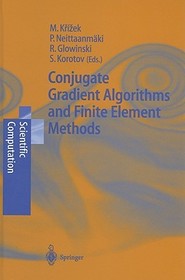
Conjugate Gradient Algorithms and Finite Element Methods
Half-Century of Contributions to Scientific Computing
Series: Scientific Computation;
- Publisher's listprice EUR 106.99
-
44 374 Ft (42 261 Ft + 5% VAT)
The price is estimated because at the time of ordering we do not know what conversion rates will apply to HUF / product currency when the book arrives. In case HUF is weaker, the price increases slightly, in case HUF is stronger, the price goes lower slightly.
- Discount 12% (cc. 5 325 Ft off)
- Discounted price 39 049 Ft (37 190 Ft + 5% VAT)
Subcribe now and take benefit of a favourable price.
Subscribe
44 374 Ft

Availability
Estimated delivery time: In stock at the publisher, but not at Prospero's office. Delivery time approx. 3-5 weeks.
Not in stock at Prospero.
Why don't you give exact delivery time?
Delivery time is estimated on our previous experiences. We give estimations only, because we order from outside Hungary, and the delivery time mainly depends on how quickly the publisher supplies the book. Faster or slower deliveries both happen, but we do our best to supply as quickly as possible.
Product details:
- Edition number 2004
- Publisher Springer Berlin Heidelberg
- Date of Publication 11 June 2004
- Number of Volumes 1 pieces, Book
- ISBN 9783540213192
- Binding Hardback
- See also 9783642621598
- No. of pages384 pages
- Size 235x155 mm
- Weight 844 g
- Language English
- Illustrations XV, 384 p. Tables, black & white 0
Categories
Long description:
The position taken in this collection of pedagogically written essays is that conjugate gradient algorithms and finite element methods complement each other extremely well.
Via their combinations practitioners have been able to solve complicated, direct and inverse, multidemensional problems modeled by ordinary or partial differential equations and inequalities, not necessarily linear, optimal control and optimal design being part of these problems.
The aim of this book is to present both methods in the context of complicated problems modeled by linear and nonlinear partial differential equations, to provide an in-depth discussion on their implementation aspects. The authors show that conjugate gradient methods and finite element methods apply to the solution of real-life problems. They address graduate students as well as experts in scientific computing.
MoreTable of Contents:
The founders of the conjugate gradient method.- Conjugate gradients and finite elements — a golden jubilee.- Geometric interpretations of conjugate gradient and related methods.- The convergence of Krylov methods and Ritz values.- An application of the Shermann-Morrison formula to the GMRES method.- A parallel CG solver based on domain decomposition and non-smooth aggregation.- Deflation in preconditioned conjugate gradient methods for finite element problems.- Nonsmooth equation method for nonlinear nonconvex optimization.- Nonstandard nonobtuse refinements of planar triangulations.- Acute versus nonobtuse tetrahedralizations.- A posteriori eror estimation of “quantities of interest” on “quantity-adapted meshes”.- Inversion of block-tridiagonal matrices and nonnegativity preservation in the numerical solution of linear parabolic PDEs.- On the nonnegativity conservation in semidiscrete parabolic problems.- Iterative solution methods of the Maxwell equations using staggered grid spatial discretization.- Iterative solution of linear variational problems in Hilbert spaces: Some conjugate gradients success stories.- On the application of preconditioning operators for nonlinear elliptic problems.- On a conjugate gradient/Newton/penalty method for the solution of obstacle problems. Application to the solution of an eikonal system with Dirichlet boundary conditions.- The use of bilinear rectangular elements in reconstruction of panoramic images.- Finite element discretization and iterative solution techniques for multiphase flows in gas-liquid reactors.- Implicit flux-corrected transport algorithm for finite element simulation of the compressible Euler equations.- Application of the PCG method in solution of a nuclear reactor criticality problem.
More



